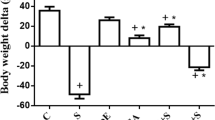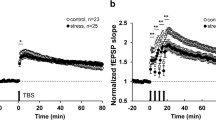Abstract
Stress adversely affects the cellular and electrophysiological mechanisms of memory; however, crocin has beneficial effects on brain functions. Nonetheless, the electrophysiological effects of using this active saffron component at different doses are not yet studied in rats under chronic restraint stress. Therefore, this study compared the impact of crocin at different doses on the excitability and long-term potentiation (LTP) in the CA1 area of rats, as well as their electroencephalogram (EEG) responses, hippocampal and frontal cortical glucose levels under chronic restraint stress (an emotional stress model). Forty rats were allocated into five groups of control, sham, restraint stress (6 h/day/21 days), and two stress groups receiving intraperitoneal injections of crocin (30, 60 mg/kg/day). Besides measuring the slope and amplitude of field excitatory postsynaptic potentials (fEPSPs) in the input–output and LTP curves, the EEG waves and hippocampal and frontal cortical glucose levels were assessed in all groups. Chronic restraint stress significantly decreased the fEPSP slope and amplitude in the input–output curves and after LTP induction. Both doses of crocin (60 and particularly 30 mg/kg) significantly improved fEPSP slope and amplitude in the stressed groups. Also, stress and crocin only at a dose of 30 mg/kg altered the EEG waves. Hippocampal and frontal cortical glucose levels displayed no significant differences in the experimental groups. Crocin at doses of 60 mg/kg/day and particularly 30 mg/kg/day reversed the harmful effects of chronic restraint stress on LTP as a cellular memory-related mechanism. However, only the lower dose of crocin affected the electrical brain activity in EEG.





Similar content being viewed by others
Data availability
Available upon request.
References
Abe K, Saito H (2000) Effects of saffron extract and its constituent crocin on learning behaviour and long-term potentiation. Phytother Res 14:149–152
Alavizadeh SH, Hosseinzadeh H (2014) Bioactivity assessment and toxicity of crocin: a comprehensive review. Food Chem Toxicol 64:65–80
Amin B, Hosseinzadeh H (2012) Evaluation of aqueous and ethanolic extracts of saffron, Crocus sativus L., and its constituents, safranal and crocin in allodynia and hyperalgesia induced by chronic constriction injury model of neuropathic pain in rats. Fitoterapia 83:888–895
Behravanfar N, Abnous K, Razavi BM, Hosseinzadeh H (2017) Effects of crocin on spatial memory impairment induced by hyoscine and its effects on bdnf, creb, and p-creb protein and mrna levels in rat hippocampus. Jundishapur J Nat Pharm Prod 12:e64315–64325
Bliss TV, Collingridge GL (1993) A synaptic model of memory: long-term potentiation in the hippocampus. Nature 361:31–39
Cahill L, McGaugh JL (1998) Mechanisms of emotional arousal and lasting declarative memory. Trends Neurosci 21:294–299
Cerqueira JJ, Pêgo JM, Taipa R, Bessa JM, Almeida OF, Sousa N (2005) Morphological correlates of corticosteroid-induced changes in prefrontal cortex-dependent behaviors. J Neurosci 25:7792–7800
Conrad CD (2010) A critical review of chronic stress effects on spatial learning and memory. Prog Neuropsychopharmacol Biol Psychiatry 34:742–755
Dastgerdi AH, Radahmadi M, Pourshanazari AA, Dastgerdi HH (2017) Effects of crocin on learning and memory in rats under chronic restraint stress with special focus on the hippocampal and frontal cortex corticosterone levels. Advanced Biomedical Research 6:157. https://doi.org/10.4103/abr.abr_107_17
Dastgerdi HH, Radahmadi M, Reisi P (2020) Comparative study of the protective effects of crocin and exercise on long-term potentiation of CA1 in rats under chronic unpredictable stress. Life Sci 256:118018
De Kloet E, Ratka A, Reul J, Sutanto W, Van Eekelen J (1987) Corticosteroid Receptor Types in Brain: Regulation and Putative Functiona. Ann N Y Acad Sci 512:351–361
Detka J et al (2015) Brain glucose metabolism in an animal model of depression. Neuroscience 295:198–208
Dharmshaktu P, Tayal V, Kalra BS (2012) Efficacy of antidepressants as analgesics: a review. J Clin Pharmacol 52:6–17
Ettehadi H, Mojabi SN, Ranjbaran M, Shams J, Sahraei H, Hedayati M, Asefi F (2013) Aqueous Extract of Saffron (Crocus sativus) Increases brain dopamine and glutamate concentrations in rats
Fee C, Prevot T, Misquitta K, Banasr M, Sibille E (2020) Chronic stress-induced behaviors correlate with exacerbated acute stress-induced cingulate cortex and ventral hippocampus activation. Neuroscience 440:113–129. https://doi.org/10.1016/j.neuroscience.2020.05.034
Georgiadou G, Grivas V, Tarantilis PA, Pitsikas N (2014) Crocins, the active constituents of Crocus Sativus L., counteracted ketamine–induced behavioural deficits in rats. Psychopharmacology 231:717–726
Gerges NZ, Stringer JL, Alkadhi KA (2001) Combination of hypothyroidism and stress abolishes early LTP in the CA1 but not dentate gyrus of hippocampus of adult rats. Brain Res 922:250–260
Ghadrdoost B et al (2011) Protective effects of saffron extract and its active constituent crocin against oxidative stress and spatial learning and memory deficits induced by chronic stress in rats. Eur J Pharmacol 667:222–229. https://doi.org/10.1016/j.ejphar.2011.05.012
Gunn BG, Brown AR, Lambert JJ, Belelli D (2011) Neurosteroids and GABAA receptor interactions: a focus on stress. Front Neurosci 5:131
Hirata R, Togashi H, Matsumoto M, Yamaguchi T, Izumi T, Yoshioka M (2008) Characterization of stress-induced suppression of long-term potentiation in the hippocampal CA1 field of freely moving rats. Brain Res 1226:27–32
Holtzer R, Scheon C, Demetriou E, Mahoney JR, Izzetoglu M, Wang C, Verghese J (2017) Stress and gender effects on prefrontal cortex oxygenation levels assessed during single and dual-task walking conditions. Eur J Neurosci 45:660–670
Hosseinzadeh H, Karimi G, Niapoor M (2004) Antidepressant effects of Crocus sativus stigma extracts and its constituents, crocin and safranal, in mice. J Med Plants 3:48–58
Jena SK (2015) Examination stress and its effect on EEG. Int J Med Sci Pub Health 11:1493–1497
Joëls M et al (2004) Effects of chronic stress on structure and cell function in rat hippocampus and hypothalamus. Stress 7:221–231
Joëls M, Krugers HJ (2007) LTP after stress: up or down? Neural Plast
Kirk IJ, Spriggs MJ, Sumner RL (2020) Human EEG and the mechanisms of memory: investigating long-term potentiation (LTP) in sensory-evoked potentials. J Roy Soc New Zeal 1–17
Knyazev GG, Savostyanov AN, Levin EA (2006) Alpha synchronization and anxiety: implications for inhibition vs. alertness hypotheses. Int J Psychophysiol 59:151–158
Lucassen P et al (2010) Regulation of adult neurogenesis by stress, sleep disruption, exercise and inflammation: Implications for depression and antidepressant action. Eur Neuropsychopharmacol 20:1–17
McEwen BS (2001) Plasticity of the hippocampus: adaptation to chronic stress and allostatic load. Ann N Y Acad Sci 933:265–277
McGaugh JL, Roozendaal B (2002) Role of adrenal stress hormones in forming lasting memories in the brain. Curr Opin Neurobiol 12:205–210
Mrdalj J et al (2013) Early and later life stress alter brain activity and sleep in rats. PloS One 8:e69923
Murao S, Yoto A, Yokogoshi H (2013) Effect of smelling green tea on mental status and EEG activity. International Journal of Affective Engineering 12:37–43
Naghibi SM, Hosseini M, Khani F, Rahimi M, Vafaee F, Rakhshandeh H, Aghaie A (2012) Effect of aqueous extract of Crocus sativus L. on morphine-induced memory impairment. Adv Pharmacol Sci
Paxinos G, Watson C (2005) The rat brain in stereotaxic coordinates. 5th ed. edn. Elsevier Academic, Amsterdam ; London
Pitsikas N, Tarantilis PA (2018) Effects of the active constituents of Crocus sativus L. crocins and their combination with memantine on recognition memory in rats. Behavioural Pharmacol 29:400–412
Pitsikas N, Zisopoulou S, Tarantilis PA, Kanakis CD, Polissiou MG, Sakellaridis N (2007) Effects of the active constituents of Crocus sativus L., crocins on recognition and spatial rats' memory. Behav Brain Res 183:141–146. https://doi.org/10.1016/j.bbr.2007.06.001
Radahmadi M, Alaei H, Sharifi MR, Hosseini N (2017) Stress biomarker responses to different protocols of forced exercise in chronically stressed rats. J Bodyw Mov Ther 21:63–68. https://doi.org/10.1016/j.jbmt.2016.05.002
Radahmadi M, Dastgerdi AH, Pourshanazari AA (2020) Effects of crocin on locomotor activity as well as novel object recognition and object location memories in chronic restraint stressed rats. Physiology and Pharmacology 24
Radahmadi M, Hosseini Dastgerdi A, Fallah N, Alaei H (2017b) The effects of acute, sub-chronic and chronic psychical stress on the brain electrical activity in male rats. Physiology and Pharmacology 21:185–192
Radahmadi M, Hosseini N, Nasimi A (2014) Effect of chronic stress on short and long-term plasticity in dentate gyrus; study of recovery and adaptation. Neuroscience 280:121–129
Schacter DL (1977) EEG theta waves and psychological phenomena: A review and analysis. Biol Psychol 5:47–82
Seo S-H, Lee J-T, Crisan M (2010) Stress and EEG Convergence and hybrid information technologies 1:413–424
Steiner GZ et al (2016) The effect of Sailuotong (SLT) on neurocognitive and cardiovascular function in healthy adults: a randomised, double-blind, placebo controlled crossover pilot trial. BMC Complement Altern Med 16:15
Sterlemann V, Rammes G, Wolf M, Liebl C, Ganea K, Müller MB, Schmidt MV (2010) Chronic social stress during adolescence induces cognitive impairment in aged mice. Hippocampus 20:540–549
Sugiura M, Shoyama Y, Saito H, Abe K (1995a) The effects of ethanol and crocin on the induction of long-term potentiation in the CA1 region of rat hippocampal slices. Jpn J Pharmacol 67:395–397
Sugiura M, Shoyama Y, Saito H, Nishlyama N (1995b) Crocin improves the ethanol-induced impairment of learning behaviors of mice in passive avoidance. Tasks Proceedings of the Japan Academy, Series B 71:319–324
Wang Y, Han T, Zhu Y, Zheng C-J, Ming Q-L, Rahman K, Qin L-P (2010) Antidepressant properties of bioactive fractions from the extract of Crocus sativus L. J Nat Med 64:24
Zak N et al (2018) Longitudinal and cross-sectional investigations of long-term potentiation-like cortical plasticity in bipolar disorder type II and healthy individuals Translational psychiatry 8:1–12
Acknowledgment
The authors would like to thank Ms. Hajaralsadat Hosseini for her helpful assistance in the laboratory. The present research was made possible through the support (No. 394933) received from the Isfahan University of Medical Sciences, Isfahan, Iran.
Funding
The present research was made possible through the support (No. 394933) received from the Isfahan University of Medical Sciences, Isfahan, Iran.
Author information
Authors and Affiliations
Corresponding author
Ethics declarations
Ethical statement
All appropriate global, regional, and/or institutional animal care and utilization rules have been obeyed. Moreover, all experiments and procedures involving animals complied with the moral standards and policies of the institution in which the research is conducted. Notably, the article did not contain any experiments on any human member.
Competing interests
The authors have no conflict of interest to declare. Also, there are no direct/indirect financial interests regarding this manuscript.
Additional information
Publisher's Note
Springer Nature remains neutral with regard to jurisdictional claims in published maps and institutional affiliations.
Rights and permissions
About this article
Cite this article
Hosseini Dastgerdi, A., Radahmadi, M. & Pourshanazari, A.A. Comparing the effects of crocin at different doses on excitability and long-term potentiation in the CA1 area, as well as the electroencephalogram responses of rats under chronic stress. Metab Brain Dis 36, 1879–1887 (2021). https://doi.org/10.1007/s11011-021-00747-y
Received:
Accepted:
Published:
Issue Date:
DOI: https://doi.org/10.1007/s11011-021-00747-y




